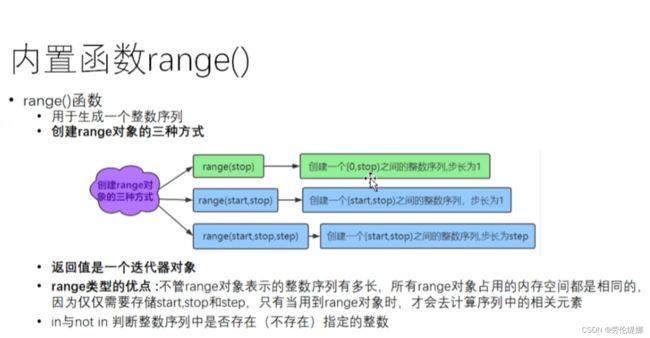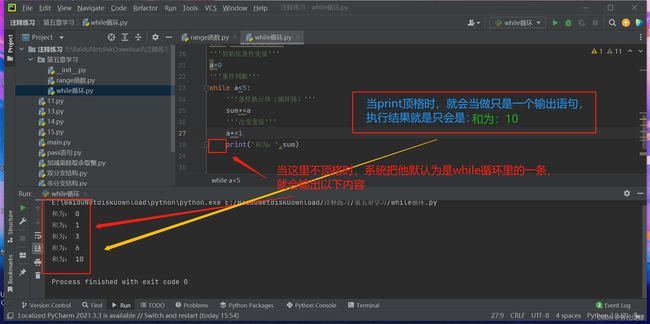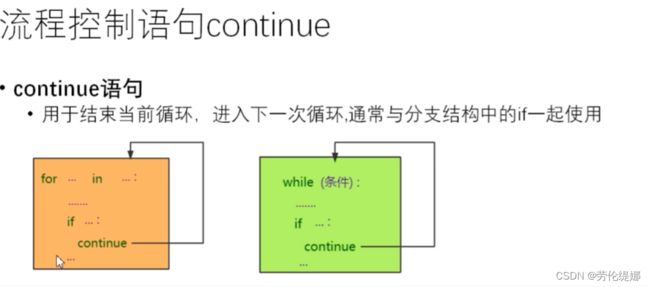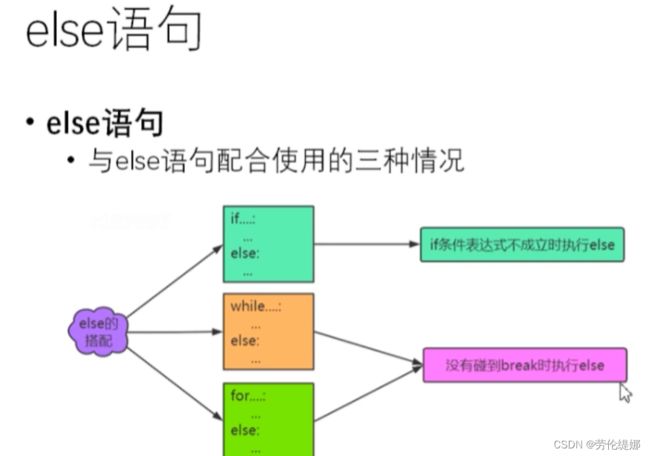【python入门】day4:循环体结构+end+字符串处理
内置函数 range()

返回值是迭代器对象
怎么理解:返回抽象对象,看不到内容物。如果想要看到具体数据,需要对迭代器使用list函数展开。
例如:
print(list®) #查看具体对象

r=range(1,10,2)
注意这里第三个参数是步长step
意思是 等差数列的等差d
print(list®) #[1,3,5,7,9]
所有range对象占用的内存空间是相同的:
因为仅仅需要存储start stop step,只有当用到range对象时,才会计算序列中的相关元素。
判断序列中是否有元素a
print(10 not in r)
返回布尔值 false 或 true
while 循环
计算1-100之间的偶数和
if not bool(a%2):
not bool也就是True
如果是a%2意思也就是a取余不是偶数,前面的布尔对象,0 none …都是表示False

for_in循环
如果在循环体中不需要使用到自定义变量,可将自定义变量写为“_”
用for_in写求偶数和
for item in 'python':
print(item)
for i in range(5):
print('haha') #将输出5次(0,1,2,3,4)
for item in range(1,101):
if item%2==0:
sum+=item
print('1--100偶数和:',sum)
用for_in写求水仙花数
#求100-999之间的水仙花数(水仙花数:个位数的三次方+十位数的三次方+百位数的三次方=原数)
for item in range(100,1000):
ge=item%10
shi=item//10%10
bai=item//100
if ge* *3+shi * *3+bai * *3=item
print(item)
密码输错锁定
流程控制语句continue
#要求输出1—50之间所有5的倍数
#(5的倍数的共同点:与5的余数为0 或者 与5的余数不为0)
for item in range(1,51):
if item%5==0:
print(item)
#若使用continue
for item in range(1,51):
if item%5!=0:
continue
print(item)
else 语句
嵌套循环
输出一个三行四列的矩形
for i in range(1,4): #行表,执行三次,一次是一行
for j in range(1,5):
print(‘*’,end=‘\t’) #不换行输出
print() #换行
end的用法

end=‘\t’ 是Python中的一个可选参数,它是print()函数的参数之一。该参数允许用户在打印输出时指定Python使用的结束字符。 在使用该参数时,在一个字符串被打印后,输出光标会定位到下一个制表符处。这就是为什么称end = '\ t’为制表符的原因。
使用end='\t’有时会使Python的输出更容易阅读。例如,如果您打印一个表格或长的数据集,使用制表符作为分隔符会使输出更易于理解。
输出九九乘法表
for i in range(1,10): #行数
for j in range(1,i+1):
print(i,'*',j,'=',i*j,end='\t')
print()
这里看上去是逗号连接了 字符串啊,还能怎么用呢:
python字符串连接的5种方法
1、加号
print'Python'+'Tab'
结果:
PythonTab
2、逗号
第二种比较特殊,使用逗号连接两个字符串,如果两个字符串用“逗号”隔开,那么这两个字符串将被连接,但是,字符串之间会多出一个空格;
print'Python','Tab'
结果:
Python Tab
3、直接连接
第三种也是Python独有的,只要把两个字符串放在一起,中间有空白或者没有空白,两个字符串将自动连接为一个字符串;
print 'Python' 'Tab'
结果:
PythonTab
print 'Python''Tab'
结果:
PythonTab(不变)
4、格式化
第四种功能比较强大,借鉴了C语言中printf函数的功能,Python提供了多种字符串格式化的方式,包括使用百分号(%)、format()方法和f-string形式。这种方式用符号“%”连接一个字符串和一组变量,字符串中的特殊标记会被自动用右边变量组中的变量替换:
print '%s%s'%('Python','Tab')
结果:
PythonTab
5、join()函数
就属于技巧了,利用字符串的函数join。这个函数接受一个列表,然后用字符串依次连接列表中每一个元素:
str_list=['Python','Tab']
a=''
print a.join(str_list)
结果:
PythonTab
其他字符串常见处理
1.字符串替换
字符串替换是将目标字符串中的指定内容替换为新的内容。在Python中,我们可以使用replace()方法来实现字符串替换。
str1 = "Hello World" #替换指定内容
result = str1.replace("World", "Python")
print(result) # 输出:Hello Python
2.字符串切割
字符串切割是将一个字符串根据指定的分隔符进行拆分成多个字符串的操作。在Python中,我们可以使用split()方法来实现字符串切割。
str1 = "Hello,Python,World" # 使用","作为分隔符进行切割
result = str1.split(",")
print(result) # 输出:['Hello', 'Python', 'World']
3.字符串查找
字符串查找是在一个字符串中查找指定的子字符串或字符的操作。在Python中,我们可以使用find()、index()和in关键字来实现字符串查找。
str1 = "Hello World" # 使用find()方法查找指定子字符串的位置,找不到返回-1
result1 = str1.find("World") # 使用index()方法查找指定子字符串的位置,找不到会抛出异常
result2 = str1.index("World") # 使用in关键字进行查找
result3 = "World" in str1
print(result1) # 输出:6
print(result2) # 输出:6
print(result3) # 输出:True
4.字符串大小写转换
字符串大小写转换是将字符串中的字母全部转换为大写或小写的操作。Python中提供了upper()和lower()方法来实现字符串的大小写转换。
str1 = "Hello World" # 转换为大写
result1 = str1.upper() # 转换为小写
result2 = str1.lower()
print(result1) # 输出:HELLO WORLD
print(result2) # 输出:hello world
5.格式化字符串
上文提到过,在Python中,我们可以使用find()、index()和in关键字来实现字符串查找。这里再写个别的例子。
# 使用百分号(%)进行格式化
name = "Alice" age = 20
result1 = "My name is %s, and I am %d years old." % (name, age)
# 使用format()方法进行格式化
result2 = "My name is {}, and I am {} years old.".format(name, age)
# 使用f-string进行格式化
result3 = f"My name is {name}, and I am {age} years old."
print(result1) # 输出:My name is Alice, and I am 20 years old.
print(result2) # 输出:My name is Alice, and I am 20 years old.
print(result3) # 输出:My name is Alice, and I am 20 years old.
————————————————————分割线————————————————————
闲云必抽。







